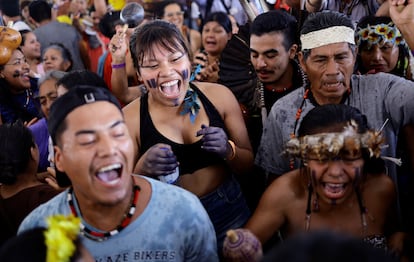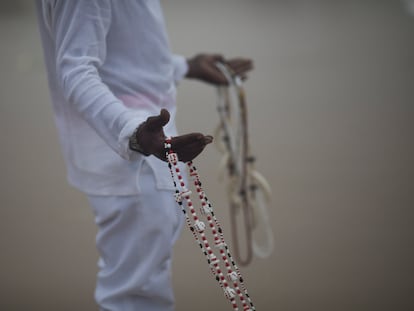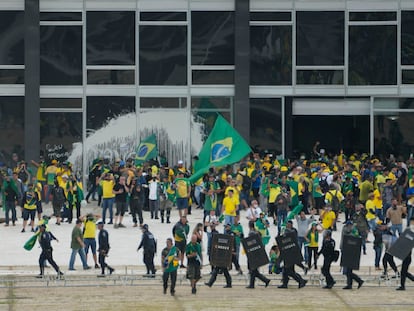Brazil’s indigenous people achieve critical victory against agribusiness in battle for land rights
The Supreme Court voted 9 to 2 against an attempt by the agricultural sector to prevent native groups from expanding their territory into land they did not inhabit in 1988, when the Constitution was approved

The indigenous people of Brazil, whose ancestors inhabited this land long before colonization and before anyone had the idea to turn it into a country, on Thursday scored a critical victory for their people and for the environment. The majority of justices in the Supreme Court, nine out of 11, rejected a legal theory defended by the agricultural sector lobby that called for establishing a time limit on land claims by indigenous people. This judicial process, which the high court first tackled in in 2021, had kept indigenous and environmental organizations on tenterhooks, since indigenous reserves are crucial to preserve the vast culture of native peoples, but also to protect nature. and biodiversity both in the Amazon rainforest and in the Brazilian states where crops and livestock continue to encroach.
Representatives of the indigenous people followed what they described as a historic trial from inside the Supreme Court itself, in Brasília. For two years, each of the hearings raised enormous expectations because this case will serve as a precedent even though it involved only one indigenous group, the Xokleng-Laklano. The decision has enormous repercussions for all of Brazil’s indigenous people, but also for agribusiness, the most dynamic sector of the economy, the one that is growing the most and creating the most jobs.
Once again, in a highly polarized Brazil, the highest court was divided into ideological camps. The two judges who voted in favor of the farmers’ theory were appointed by the previous president, the far-right Jair Bolsonaro, who while in office refused to designate a single square centimeter of new land for indigenous people or to preserve biodiversity.
The agribusiness lobby argued that indigenous people could not claim territories in which they were not already settled on the day the Constitution was promulgated, that is, on October 5, 1988. Their argument was that this time limit would help resolve countless land disputes and bring legal security to agricultural producers. For the indigenous people, imposing this restriction would have meant legalizing multiple expulsions that occurred before that date, especially during the dictatorship, which ended in 1985.
Indigenous people are a very small minority of Brazilians (1.7 million among those who live in villages and cities) and their lands make up more than 13% of the territory. They perform a vital function for the planet because they are always in the areas where nature is best preserved. In satellite images taken in the Amazon or other ecosystems, indigenous lands and natural reserves are easy to identify because they are usually green islands.
“We’ve won the battle, but not the war. We will continue to fight for Indigenous territories to be demarcated, so that the rights of indigenous peoples are safeguarded and protected,” said Dinamam Tuxá, executive coordinator of APIB, the organization that brings together the indigenous peoples of Brazil and which, until a few months ago, was headed by Sonia Guajajara, now Minister of Indigenous Peoples in the government of Luiz Inácio Lula da Silva.
The process of demarcating indigenous lands was very intense in the first years after Brazil regained democracy in 1985. But a decade ago it was stopped due to the political, social and economic crisis that the country was going through and in the last four years it was completely put on hold. Bolsonaro promised in his first presidential campaign not to legalize “a single centimeter of indigenous land,” and he kept his word. Lula has resumed the process but at a much more timid pace than the indigenous people and environmentalists would have liked. He resumed the creation of indigenous lands with eight areas carefully chosen from the long list of requests and avoided those that could be the most conflict-ridden in both political and legal terms.
The case that the Supreme Court has now ruled on concerns a specific territory in the State of Santa Catarina, in the south of the country. In 2009, a first instance judge stripped the Ibirama-Laklano territory of its status as an indigenous reserve, arguing that the natives were not there on the day the Constitution came into force. But Thursday’s decision is not an end to the matter. The agricultural lobby has sought an alternative way to achieve its goals, and the Senate is debating a bill on the matter. A vote is expected next week.
Sign up for our weekly newsletter to get more English-language news coverage from EL PAÍS USA Edition
Tu suscripción se está usando en otro dispositivo
¿Quieres añadir otro usuario a tu suscripción?
Si continúas leyendo en este dispositivo, no se podrá leer en el otro.
FlechaTu suscripción se está usando en otro dispositivo y solo puedes acceder a EL PAÍS desde un dispositivo a la vez.
Si quieres compartir tu cuenta, cambia tu suscripción a la modalidad Premium, así podrás añadir otro usuario. Cada uno accederá con su propia cuenta de email, lo que os permitirá personalizar vuestra experiencia en EL PAÍS.
¿Tienes una suscripción de empresa? Accede aquí para contratar más cuentas.
En el caso de no saber quién está usando tu cuenta, te recomendamos cambiar tu contraseña aquí.
Si decides continuar compartiendo tu cuenta, este mensaje se mostrará en tu dispositivo y en el de la otra persona que está usando tu cuenta de forma indefinida, afectando a tu experiencia de lectura. Puedes consultar aquí los términos y condiciones de la suscripción digital.
More information
Últimas noticias
Most viewed
- Sinaloa Cartel war is taking its toll on Los Chapitos
- Oona Chaplin: ‘I told James Cameron that I was living in a treehouse and starting a permaculture project with a friend’
- Reinhard Genzel, Nobel laureate in physics: ‘One-minute videos will never give you the truth’
- Why the price of coffee has skyrocketed: from Brazilian plantations to specialty coffee houses
- Silver prices are going crazy: This is what’s fueling the rally










































